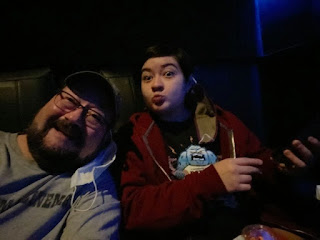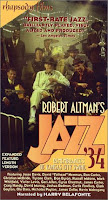RETURN TO MOVIE FOREVER: SCOTT PILGRIM VS. THE PANDEMIC, plus GODZILLA VS. KONG
So we went to the movies last Sunday night. 422 days previous, to celebrate Emma’s 20th birthday, we saw our last movie in a theater. And on Sunday night, May 2, the longest drought of theatrical moviegoing I’ve ever been through came to an end with a made-to-order experience for Daddy and child. Back in August 2010, I took my daughter Emma to see Scott Pilgrim vs. the World. They were only 10, and I kinda expected that my wife might not appreciate them seeing a PG-13 picture like this, so we snuck away and didn’t tell Mom where we were going or what we were seeing. I remember the presentation in the cracker box cinema where we saw it being pretty shoddy, but we had a good time together and the movie, once it came out on Blu-ray, became a real touchstone movie for Emma, who has probably seen it ten times since then. I’ve seen it a few times since then too, but other than the time spent together watching it, SPVTW never meant as much to me as it did to my kid.
Until Sunday night, that is. When I bought our tickets I thought, I know Emma would love to see this, but do I really want this movie to be the first one I’ve seen on the big screen in over a year? Turns out it couldn’t have been a better choice, in terms of sheer awesome-itude of the snazzy presentation— the movie has been retooled, in honor of its 10th anniversary, specifically for Dolby Vision-Dolby Atmos Sound theaters, for maximum audio-visual impact— and, of course, as a super-platinum upgrade on our original surreptitious movie outing 10+ years ago. Naturally, we were just excited to be there, but I think I may have underrated just how high the level of anticipation for both of us really was. Just prior to unspooling a bunch of trailers that, whether or not the films themselves turn out to be any good, got us excited at just the prospect of a possible future that included going to the movies, a big ad for the theater chain came on that said simply, “AMC says welcome back to the movies!” And yeah, I got pretty choked up and shed a tear or two over that message because here we were, doing something that this time last year I seriously thought we might not ever do again.
And I also undersold to myself just what being in an audience who was taking social distancing protocols seriously would mean, gathered together to enjoy a movie together with other people, to hear everyone responding, engaged, laughing, having what felt like a special experience, one in which seeing a movie in public was truly appreciated, a activity no longer taken for granted, which felt like a privilege as much as entertainment. Surely I have never enjoyed or appreciated Scott Pilgrim vs. the World as much as I did tonight— it’s as much fun as I can imagine having with a movie populated almost entirely by people I would probably actively avoid in real life. (Except maybe Knives Chau!) And it’s probably the most eye-popping explosion of director Edgar Wright’s visual imagination, in service to expressing both the worldview of the graphic novel’s definitive, indulgent generational satire/wish fulfillment and the experience of what might be going on in the jittery, self-obsessed mind of the novel’s ideal reader. Scott Pilgrim vs. the World is an exhausting, hilarious, annoying, exuberant picture, and I can even forgive its outburst of directorial confidence for probably having led directly to the markedly inferior Baby Driver.
I’m so happy that my now-21-year-old offspring still wants to go see movies with Dad, and that said offspring is so aware and sympathetic to how much that experience means to the old man. That we seem to be on the cusp of making it a more regular experience again has filled me with a certain hope that maybe some semblance of normal might be waiting just around the corner. And when we do resume this glorious habit, maybe we won’t take it so much for granted any longer. It was a thrill to be at the movies with Emma tonight. Tomorrow, we’re headed back for our second helping of Godzilla vs. Kong. And then who knows? If our beloved Vista Theater in east Hollywood reopens, there really will be a celebration.
And while we’re at it, I might as well admit that I loved Godzilla vs. Kong. My two daughters and I had a great time with it, even if it was only on HBO Max— we turned it up loud, laughing and shouting and screaming in all the right places. The damn thing must have taken a nation’s worth of craftsmen and artists to compose, but it lumbers not— in light of the four-hour Justice League especially, this is as fleet of foot and spirit as you could hope for in a movie about giant beasts asserting their essential (but not necessarily hostile-to-mankind) beastliness and laying waste to their surroundings, including a surreally gorgeous nighttime Hong Kong that’s neon-lit for maximum eye-popping monster fun. But the highlight for me was the mind-and-perspective boggling landscape of Hollow Earth, revealed when our human heroes travel beneath the surface to find out where the ancestors and cohabitants of Kong and Godzilla have been calling home for centuries. It’s a truly spectacular vision of a hidden world within our own that itself warrants at least a couple more viewings to be even close to fully taken in.
Critic Matt Zoller Seitz is being summarily roasted in the comments following his review at RogerEbert.com for having the audacity to give this movie a four-star rating, as if he were only full-tilt slobbering over it like a Christopher Nolan fanboy. The difference being, of course, that Seitz knows that GVK is, at its heart and on its face, an undeniably silly concept, but one which he chooses to approach with good humor and more than the occasional nod to that silliness while taking entirely seriously the art and craft of the show and his own response to it. (The Nolanoids play an entirely different, poker-faced game of you either love it or deserve to die.) If you love cinema as an art form, you’re supposed to reflexively shun a big, loud, commercial piece of work like Godzilla vs. Kong, but whether or not you think he’s lost his mind (as most of those commenters where his review is posted clearly do), Seitz’s response is not cynical in the least; I read the review after I saw the movie, and now I’m all the more glad for his sincerity. The big boys (plus a surprise guest) are worth that second helping coming up tomorrow, this time on the big screen. And Hollow Earth awaits as well.

























